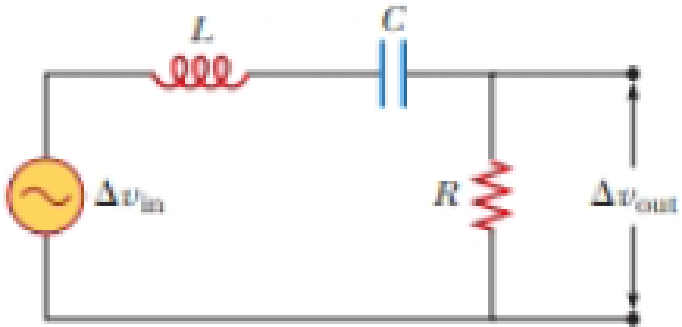
The resistor in Figure P32.49 represents the midrange speaker in a three-speaker system. Assume its resistance to be constant at 8.00 Ω. The source represents an audio amplifier producing signals of uniform amplitude ΔVmax = 10.0 V at all audio frequencies. The inductor and capacitor are to function as a band-pass filter with
Figure P32.49

(a)
The required value of inductance
Answer to Problem 49CP
The required value of inductance
Explanation of Solution
Given info: The value of resistance is
Formula to calculate the output potential difference is,
Here,
Formula to calculate the input potential difference is,
Here,
Divide equation (1) and equation (1).
Formula to calculate the inductive reactance of the circuit is,
Here,
Formula to calculate the inductive reactance of the circuit is,
Here,
Formula to calculate the impedance of the circuit is,
Here,
Substitute
At low frequency that is
Substitute
Substitute
Solve the equation further,
Divide the equation by
At high frequency that is
Substitute
Substitute
Solve the equation further,
Subtract the equation (5) and equation (6) to find the value of
Conclusion:
Therefore, the required value of inductance
(b)
The required value of capacitance
Answer to Problem 49CP
The required value of capacitance
Explanation of Solution
Given info: The value of resistance is
The equation (6) is given as,
Substitute
Conclusion:
Therefore, the required value of capacitance
(c)
The maximum value of the ratio
Answer to Problem 49CP
The maximum value of the ratio
Explanation of Solution
Given info: The value of resistance is
The value
At resonance condition,
Substitute
Conclusion:
Therefore, the maximum value of the ratio
(d)
The frequency
Answer to Problem 49CP
The frequency
Explanation of Solution
Given info: The value of resistance is
Since the ratio
Formula to calculate the resonance frequency is,
Substitute
Conclusion:
Therefore, the frequency
(e)
The phase shift between
Answer to Problem 49CP
The phase shift between
Explanation of Solution
Given info: The value of resistance is
Formula to calculate the phase shift between
At
Substitute
At
Substitute
At
Substitute
Conclusion:
Therefore, the phase shift between
(f)
The average power transferred to the speaker at
Answer to Problem 49CP
The average power transferred to the speaker at
Explanation of Solution
Given info: The value of resistance is
Formula to calculate the rms output voltage is,
Formula to calculate the power deliver to the speaker is,
Substitute
For low frequency
Substitute
Substitute
For resonance frequency
Substitute
Substitute
Conclusion:
Therefore, the average power transferred to the speaker at
(g)
The quality factor of the circuit.
Answer to Problem 49CP
The quality factor of the circuit is
Explanation of Solution
Given info: The value of resistance is
Formula to calculate the quality factor is,
Substitute
Conclusion:
Therefore, the quality factor of the circuit is
Want to see more full solutions like this?
Chapter 32 Solutions
Physics for Scientists and Engineers with Modern Physics
- Which of the following best describes how to calculate the average acceleration of any object? Average acceleration is always halfway between the initial acceleration of an object and its final acceleration. Average acceleration is always equal to the change in velocity of an object divided by the time interval. Average acceleration is always equal to the displacement of an object divided by the time interval. Average acceleration is always equal to the change in speed of an object divided by the time interval.arrow_forwardThe figure shows the velocity versus time graph for a car driving on a straight road. Which of the following best describes the acceleration of the car? v (m/s) t(s) The acceleration of the car is negative and decreasing. The acceleration of the car is constant. The acceleration of the car is positive and increasing. The acceleration of the car is positive and decreasing. The acceleration of the car is negative and increasing.arrow_forwardWhich figure could represent the velocity versus time graph of a motorcycle whose speed is increasing? v (m/s) v (m/s) t(s) t(s)arrow_forward
- Unlike speed, velocity is a the statement? Poisition. Direction. Vector. Scalar. quantity. Which one of the following completesarrow_forwardNo chatgpt pls will upvote Already got wrong chatgpt answerarrow_forward3.63 • Leaping the River II. A physics professor did daredevil stunts in his spare time. His last stunt was an attempt to jump across a river on a motorcycle (Fig. P3.63). The takeoff ramp was inclined at 53.0°, the river was 40.0 m wide, and the far bank was 15.0 m lower than the top of the ramp. The river itself was 100 m below the ramp. Ignore air resistance. (a) What should his speed have been at the top of the ramp to have just made it to the edge of the far bank? (b) If his speed was only half the value found in part (a), where did he land? Figure P3.63 53.0° 100 m 40.0 m→ 15.0 marrow_forward
 Physics for Scientists and Engineers, Technology ...PhysicsISBN:9781305116399Author:Raymond A. Serway, John W. JewettPublisher:Cengage Learning
Physics for Scientists and Engineers, Technology ...PhysicsISBN:9781305116399Author:Raymond A. Serway, John W. JewettPublisher:Cengage Learning Physics for Scientists and Engineers: Foundations...PhysicsISBN:9781133939146Author:Katz, Debora M.Publisher:Cengage Learning
Physics for Scientists and Engineers: Foundations...PhysicsISBN:9781133939146Author:Katz, Debora M.Publisher:Cengage Learning
 Physics for Scientists and EngineersPhysicsISBN:9781337553278Author:Raymond A. Serway, John W. JewettPublisher:Cengage Learning
Physics for Scientists and EngineersPhysicsISBN:9781337553278Author:Raymond A. Serway, John W. JewettPublisher:Cengage Learning Physics for Scientists and Engineers with Modern ...PhysicsISBN:9781337553292Author:Raymond A. Serway, John W. JewettPublisher:Cengage Learning
Physics for Scientists and Engineers with Modern ...PhysicsISBN:9781337553292Author:Raymond A. Serway, John W. JewettPublisher:Cengage Learning College PhysicsPhysicsISBN:9781305952300Author:Raymond A. Serway, Chris VuillePublisher:Cengage Learning
College PhysicsPhysicsISBN:9781305952300Author:Raymond A. Serway, Chris VuillePublisher:Cengage Learning





